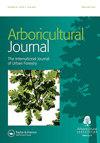Indonesian urban forest policies, practice and bioenergy potential of urban forest tree species
Q3 Agricultural and Biological Sciences
引用次数: 2
Abstract
ABSTRACT This study examines Indonesian urban forest policy, practice, and potential with reference to forest composition and bioenergy potential. The results showed that there are challenges in the implementation of urban forest policies into urban forest practices. For example, the land size allocation for urban forests in Jakarta, Surabaya, and Malang is still not in accordance with the existing policies as their land size is far less than 10% of these total areas. Predominant tree species in Indonesian urban forestry are Pterocarpus indicus, Delonix regia, Polyalthia longifolia, Lagerstroemia speciosa, Mimusops elengi, Samanea saman, Tectona grandis, Ficus benjamina, Mangifera indica, and Tamarindus indica. These trees are considered as multipurpose species that can be utilised for bioenergy, wood-based furniture, food and foraging, medicine, and many other uses. Aside from firewood and charcoal, these trees should be explored for their potential as biofuel, biogas, bio-pellet, and electricity generation. Bioenergy potential of urban forest trees can be an important consideration for the Government of Indonesia to actualise the potential of the urban forest and to create energy-independent cities.印度尼西亚城市森林政策、实践和城市森林树种的生物能源潜力
本研究考察了印尼城市森林政策、实践和潜力,参考了森林组成和生物能源潜力。结果表明,城市森林政策在城市森林实践中的实施存在挑战。例如,雅加达、泗水和玛琅的城市森林的土地面积分配仍然不符合现有政策,因为它们的土地面积远远不到这些总面积的10%。印度尼西亚城市林业的优势树种有:梧桐、龙凤、长叶蓼、紫花紫薇、长叶紫薇、长叶紫薇、长叶紫薇、大地木、榕树、芒果和柽柳。这些树木被认为是多用途物种,可用于生物能源、木制家具、食品和觅食、医药和许多其他用途。除了柴火和木炭之外,这些树木还应该开发其作为生物燃料、沼气、生物颗粒和发电的潜力。城市森林树木的生物能源潜力可以成为印度尼西亚政府实现城市森林潜力和创建能源独立城市的一个重要考虑因素。
本文章由计算机程序翻译,如有差异,请以英文原文为准。
求助全文
约1分钟内获得全文
求助全文
来源期刊

Arboricultural Journal
Agricultural and Biological Sciences-Agronomy and Crop Science
CiteScore
2.40
自引率
0.00%
发文量
28
期刊介绍:
The Arboricultural Journal is published and issued free to members* of the Arboricultural Association. It contains valuable technical, research and scientific information about all aspects of arboriculture.
 求助内容:
求助内容: 应助结果提醒方式:
应助结果提醒方式:


